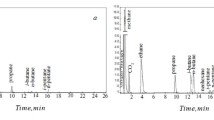Summary
A column switching system for two columns is described, designated as a dual channel series-parallel arrangement, which permits switching from series operation of the two columns to dual channel parallel operation of the same columns during one analysis. This system requires two independent gas lines with two flow controllers, two detectors and a four-way valve. In the parallel arrangement, the chromatograms are recorded simultaneously in true dual-channel operation. This system permits the separation in a second column of components that are not separated in the first one, without interrupting the chromatogram of the first column. The general features and application of the system are discussed, especially with regard to the combination of a partition column with an adsorption column, and the analytical possibilities are illustrated by means of the analysis of a natural gas sample.
The advantages and disadvantages of switching systems working with and without switching valves for the dual channel series-parallel arrangement are outlined. The features of the employed four-way valve, which is the crucial part of the system as far as analysis quality is concerned, are discused with special reference to gas analyses.
Zusammenfassung
Es wird ein System zur Säulenschaltung beschrieben, das als Zweikanal-Serien-Parallel-Anordnung bezeichnet wird, bei dem in einem Analysengang zwei gas-chromatographische Säulen von der Serie in eine Parallelanordnung geschaltet werden können. Für dieses Schaltsystem sind zwei unabhängige Trägergasstrecken, zwei Detektoren sowie ein 4-Wege-Umschalthahn erforderlich. In der Parallelanordnung laufen die Chromatogramme im echten Zweikanal-Betrieb gleichzeitig ab. Mit dieser Anordnung ist es möglich, Komponenten, die von der ersten Säule nicht getrennt werden, durch eine zweite Säule aufzutrennen, ohne dass der weitere Ablauf des Chromatogramms aus der ersten Säule gestört wird. Anwendungsmöglichkeiten, speziell für die Kombination von Verteilungssäulen mit Adsorptionssäulen werden diskutiert, und am Beispiel einer Erdgasanalyse wird die praktische Anwendung dieses Schaltsystems gezeigt. Auf die Vor- und Nachteile von Umschaltsystemen, welche mit und ohne Umschalthähne arbeiten, für die Zweikanal-Serien-Parallel-Anordnung wird eingegangen. Die Eigenschaften des verwendeten Umschalthahns, welcher der qualitativ entscheidende Bauteil des Systems ist, werden im Hinblick auf das spezielle Anwendungsgebiet von Gasanalysen diskutiert.
Sommaire
On décrit un système de commutation de colonnes appellé système de double colonne en série/paralléle. Le dispositif permet d'effectuer pendant une analyse, la commutation de deux colonnes chromatographiques du montage en série ou montage en parallèle. Pour ce système, deux circuits de gaz indépendants, deux détecteurs, ainsi qu'une vanne à 4 voies sont nécessaires. Dans le montage en paralléle, les chromatogrammes se déroulent simultanément comme dans le fonctionnement en double circuit. Ce système permet de séparer, sur une deuxième colonne, des composés qui ne sont pas séparés sur la première, sans pour autant interrompe, le chromatogramme de la première colonne. Des possibilités d'application sont discutées, particulièrement en ce qui concerne la combinaison de colonnes de partage avec des colonnes d'adsorption. Une analyses de gaz naturel sert comme exemple pour l'application pratique de ce système de commutation.
Les avantages et désavantages de systèmes de commutation fonctionnant avec et sans vanne de commutation des deux colonnes en série ou en parallèle sont examines. Les qualités de la vanne à 4 voies utilisée, qui est la partie essentielle du système, sont discutées en vue de l'application particulière aux analyses de gaz.
Similar content being viewed by others
Literatur
Pauschmann, H., Die Umschaltung von Trennsäulen. Angewandte Gas-Chromatographie, Heft 4, Bodenseewerk Perkin-Elmer & Co. G.m.b.H., D-777 Überlingen
Deans, D.R., Chromatographia,1, 16 (1968)
Simon, M.C., Snyder, L.R., Anal. Chem.30, 32 (1958).
Standard Method for Analysis of Natural Gas by Gas Chromatography. ASTM Designation: D 1945–64
Author information
Authors and Affiliations
Rights and permissions
About this article
Cite this article
Kolb, B., Wiedeking, E. Zweikanal-Serien-Parallel-Anordnung von gas-chromatographischen Trennsäulen durch Säulenschaltung. Chromatographia 1, 98–103 (1968). https://doi.org/10.1007/BF02258942
Received:
Accepted:
Issue Date:
DOI: https://doi.org/10.1007/BF02258942




